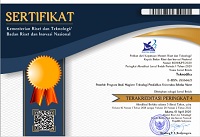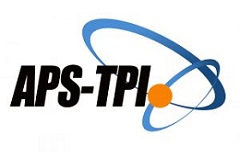The Effect of Task Technology Fit in Google Classroom Media on Learning Achievement in Higher Education: Goodhue and Thompson’s Theory
Abstract
Keywords
Full Text:
PDFReferences
Bere, A. (2018). Applying an extended task-technology fit for establishing determinants of mobile learning: An instant messaging initiative. Journal of Information Systems Education, 29(4), 239–252.
Elçi, A., & Abubakar, A. M. (2021). The configurational effects of task-technology fit, technology-induced engagement and motivation on learning performance during Covid-19 pandemic: An fsQCA approach. Education and Information Technologies, 26(6), 7259–7277. https://doi.org/10.1007/s10639-021-10580-6
Gama, M. A., & Bambang, S. (2019). Pengaruh Task-Technology Fit Terhadap Prestasi Belajar Mahasiswa Akuntansi Dimediasi Oleh Pemanfaatan Smartphone. Jurnal Ilmu Dan Riset Akuntansi (JIRA), 8(10). http://jurnalmahasiswa.stiesia.ac.id/index.php/jira/article/view/4289
Goodhue, D. L. (1998). Development and measurement validity of a task-technology fit instrument for user evaluations of information systems. Decision Sciences, 29(1), 105–138. https://doi.org/10.1111/j.1540-5915.1998.tb01346.x
Hisbani, N. A., Karim, M., & Malik, & I. (2015). Penerapan Inovasi Pelayanan Publik Di Dinas Kependudukan Dan Catatan Sipil Kabupaten Enrekang. Jurnal Administrasi Publik, 1(3), 265–276. https://journal.unismuh.ac.id/index.php/kolaborasi/article/view/705
Islamiyah, N. (2019). Pengaruh Fasilitas Belajar dan Motivasi Belajar Terhadap Prestasi Belajar Mahasiswa Jurusan Pendidikan Ekonomi 2017 Universitas Negeri Surabaya. JPEKA: Jurnal Pendidikan Ekonomi, Manajemen Dan Keuangan, 3(1), 23. https://doi.org/10.26740/jpeka.v3n1.p23-32
Kasmawati, Y., & Kuncoro, A. W. (2021). Peningkatan Kepuasan Mahasiswa dalam Pembelajaran E-Learning melalui Task Technologi Fit dan Kualitas Informasi. Jurnal Penelitian Dan Pengembangan Pendidikan, 5(3), 355. https://doi.org/10.23887/jppp.v5i3.39977
Kurniabudi, K., & Assegaff, S. (2018). Model Persepsi Penggunaan Media Sosial pada Perkuliahan dengan Modifikasi Task Technology Fit dan Expectation Confirmation Theory. Jurnal Teknologi Dan Sistem Informasi, 4(3), 107–114. https://doi.org/10.25077/teknosi.v4i3.2018.114
Kurniawan, B., & Purnomo, A. (2020). aditra,+1.+Bayu+Kurniawan+1-9. 4(1), 1–9.
Pakpahan, R., & Fitriani, Y. (2020). Analisa Pemafaatan Teknologi Informasi Dalam Pemeblajaran Jarak Jauh Di Tengah Pandemi Virus Corona Covid-19. JISAMAR (Journal of Information System, Applied, Management, Accounting and Research), 4(2), 30–36.
Priyastuti, M. T., & Suhadi, S. (2020). Kepuasaan Mahasiswa terhadap Pembelajaran Daring Selama Pandemi Covid-19. Journal of Language and Health, 1(2), 49–56. https://doi.org/10.37287/jlh.v1i2.383
Purnomo, D. (2017). Model Prototyping Pada Pengembangan Sistem Informasi. J I M P - Jurnal Informatika Merdeka Pasuruan, 2(2), 54–61. https://doi.org/10.37438/jimp.v2i2.67
Rahayu, S. T., Handoyo, B., & Rosyida, F. (2022). Peningkatan kemampuan berpikir spasial siswa melalui penerapan Project Based Learning dengan menggunakan platform google classroom. Jurnal Integrasi Dan Harmoni Inovatif Ilmu-Ilmu Sosial (JIHI3S), 2(1), 68–80. https://doi.org/10.17977/um063v2i1p68-80
Rai, R. S., & Selnes, F. (2019). Conceptualizing task-technology fit and the effect on adoption – A case study of a digital textbook service. Information and Management, 56(8), 103161. https://doi.org/10.1016/j.im.2019.04.004
Reza, V., Snapp, P., Dalam, E., Di, I. M. A., Socialization, A., Cadger, O. F., To, M., Cadger, S., Programpadang, R., Hukum, F., Hatta, U. B. U. B., Sipil, F. T., Hatta, U. B. U. B., Danilo Gomes de Arruda, Bustamam, N., Suryani, S., Nasution, M. S., Prayitno, B., Rois, I., … Rezekiana, L. (2020). No 主観的健康感を中心とした在宅高齢者における 健康関連指標に関する共分散構造分析Title. Business Law Binus, 7(2), 33–48. http://repository.radenintan.ac.id/11375/1/PERPUS PUSAT.pdf%0Ahttp://business-law.binus.ac.id/2015/10/08/pariwisata-syariah/%0Ahttps://www.ptonline.com/articles/how-to-get-better-mfi-results%0Ahttps://journal.uir.ac.id/index.php/kiat/article/view/8839
Ridwan, T., & Umam, A. F. (2020). PENGARUH MEDIA PEMBELAJARAN GOOGLE CLASSROOM MAHASISWA Belajar merupakan proses seseorang untuk dapat mengetahui , memahami dan dapat melakukan dari hal yang tadinya belum diketahui , dipahami dan tidak dapat dilakukan . Proses belajar yang kurang maksima. Jurnal Ilmiah Indonesia, 1(1), 37–46. http://cerdika.publikasiindonesia.id/index.php/cerdika/article/view/3/18%0Ahttps://cerdika.publikasiindonesia.id/index.php/cerdika/article/view/3/7
Rohhadi, W. (2021). Pengaruh FASILITAS BELAJAR DAN MOTIVASI BELAJAR TERHADAP PRESTASI BELAJAR ILMU PENGETAHUAN SOSIAL SISWA SMP SWASTA DI KABUPATEN TANGGERANG. Herodotus: Jurnal Pendidikan IPS, 3(58), 18–26. https://journal.lppmunindra.ac.id/index.php/herodotus/article/view/5965
Rozak, A., & Albantani, A. M. (2018). Desain Perkuliahan Bahasa Arab Melalui Google Classroom. Arabiyat : Jurnal Pendidikan Bahasa Arab Dan Kebahasaaraban, 5(1), 83–102. https://doi.org/10.15408/a.v5i1.7481
Susanto, H., Irmanita, W., & Meidy Syurbakti, M. (2022). Analisis Penggunaan Media Digital Dalam Pembelajaran Sejarah Daring Masa Pandemi Covid-19. Candrasangkala: Jurnal Pendidikan Dan Sejarah, 8(1), 13–24.
Wahyuni, H., Erwantiningsih, E., & Pudyaningsih, R. (2021). Analisis Penggunaan Google Classroom Pada Masa Pandemi Covid – 19 Terhadap Efektivitas Pembelajaran Mahasiswa. Jurnal Pendidikan Ekonomi Undiksha, 13(2), 253. https://doi.org/10.23887/jjpe.v13i2.31732
Widagdo, Pamilih, Putut, Susanto, D. T. (2015). Pengaruh Kesesuaian Teknologi Pada Tugas (Task Technology Fit ) Terhadap Kinerja Individu Dalam Menggunakan Teknologi Informasi (Studi Kasus : Universitas Mulawarman). Prosiding Seminar Nasional Manajemen Teknologi XXIII, August, 1–12.
Yasir, M., Ibrahim, M., & Widodo, W. (2017). Pengembangan Perangkat Pembelajaran Biologi Berbasis Metakognitif Untuk Melatihkan Kejujuran Siswa. JPPS (Jurnal Penelitian Pendidikan Sains), 5(2), 1009. https://doi.org/10.26740/jpps.v5n2.p1009-1015
Refbacks
- There are currently no refbacks.





.png)













